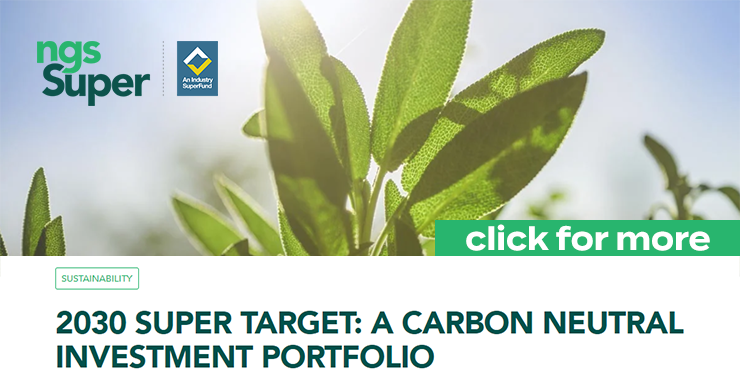Super fund accelerates race to carbon neutral with 2030 target
NGS Super is leading the way, with the $12.8 billion fund targeting a carbon neutral investment portfolio by 2030, a timeframe that no other Australian super fund has committed to so far.
A number of superannuation funds have responded to consumer expectations and a changing regulatory landscape when it comes to climate change. However, NGS Super’s ambitious target of 2030 differentiates the Fund.
NGS Super Chief Investment Officer Ben Squires said:
“Our target of being carbon neutral by 2030 is the next step in integrating responsible investment for better returns for our members.”
“We believe integrating ESG and responsible investment principles is vital to managing risk within our investment portfolio and providing our members with better risk-adjusted returns
“We acknowledge that pursuing a carbon neutral target date of 2030 is ambitious, but we also believe a 2050 target is misaligned with the timeframes the scientific community has given in relation to stemming human-induced climate change.”
As custodians of nearly AUD$3 trillion invested in Australian and global equities and other assets, super funds play a significant role in positively shifting the dial to address the risks of climate change.
Higher expectations from members, regulators and industry bodies, plus increasing awareness of the investment risks involved with climate change, are driving positive action within the super industry and the broader institutional investment sector. NGS Super believes that if climate change is not acknowledged in investment portfolios with more immediate action, this quickly shifting landscape will present further risk to the retirement savings of millions of Australians.
Squires explained that “divestment of some companies and stocks will be necessary to achieve our 2030 target, but first and foremost, we will use engagement to effect change, as well as seeking out positive investments in companies and businesses that are actively looking to transition to the low carbon economy. We have already started that journey.
“We’re aiming to achieve carbon neutrality without purchasing carbon offsets, but we may need to use offsets from time to time. Our focus will be on carbon reduction and investing in carbon positive assets or companies in areas such as clean energy infrastructure (wind and solar projects), storage infrastructure, or grid technology. We’ll access these opportunities in several ways, including investing in infrastructure or private equity funds, direct project-level investment, securitised bonds or equity, investing in green buildings, or funding the balance sheets of corporate developers in both debt and equity,” he said.
Squires added, “We are committed to providing our members with information about our strategy and how it will affect them throughout the transition. This is as much about mitigating investment risk as it is about mitigating climate change risk.”
For the purposes of this transition, carbon neutral is defined in terms of carbon dioxide (CO2). CO2 is by far the largest contributor to greenhouse gases — in 2018 approximately 81% of the total greenhouse gases emitted were carbon dioxide, hence a “carbon neutral” goal as opposed to a “net zero emissions” goal.
Read more about NGS Super 2030 Super Target – click here


